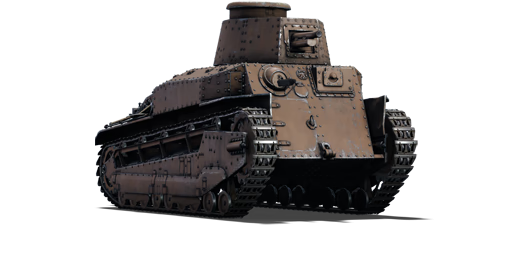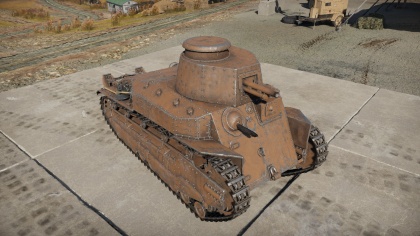I-Go Ko
Contents
Description
The Type 89b I-Go Ko is a reserve Rank I Japanese light tank with a battle rating of 1.0. It was introduced in Update 1.65 "Way of the Samurai" along with the rest of the initial Japanese Ground Forces Tree.
General info
Survivability and armour
Armour Type:
- Rolled homogeneous armour
| Armour | Front | Sides | Rear | Roof |
|---|---|---|---|---|
| Hull | 17 mm (32°) Front glacis | 17 mm Top 17 + 17 mm Bottom |
17 mm (61°) Top 17 + 7 mm Bottom |
10 mm |
| Turret | 17 mm (9°) Turret front 25 mm (10°) Gun mantlet |
15 mm (10-12°) | 15 mm (11°) | 10 mm |
| Armour | Sides | Roof | ||
| Cupola | 15 mm | 10 mm |
Notes:
- Suspension wheels and tracks are both 15 mm thick.
Mobility
| Mobility characteristic | ||
|---|---|---|
| Weight (tons) | Add-on Armor weight (tons) |
Max speed (km/h) |
| 11.5 | N/A | 30 (AB) |
| 27 (RB/SB) | ||
| Engine power (horsepower) | ||
| Mode | Stock | Upgraded |
| Arcade | 183 | 225 |
| Realistic/Simulator | 104 | 118 |
| Power-to-weight ratio (hp/ton) | ||
| Mode | Stock | Upgraded |
| Arcade | 15.91 | 19.56 |
| Realistic/Simulator | 9.04 | 10.26 |
Armaments
Main armament
| 57 mm Type 90 | |||||
|---|---|---|---|---|---|
| Capacity | Vertical guidance |
Horizontal guidance |
Stabilizer | ||
| 100 | -15°/+20° | ±180° | Vertical | ||
| Turret rotation speed (°/s) | |||||
| Mode | Stock | Upgraded | Prior + Full crew | Prior + Expert qualif. | Prior + Ace qualif. |
| Arcade | 9.00 | 12.50 | 15.20 | _.__ | 17.88 |
| Realistic | 9.00 | 10.60 | 12.90 | _.__ | 15.20 |
| Reloading rate (seconds) | |||||
| Stock | Prior + Full crew | Prior + Expert qualif. | Prior + Ace qualif. | ||
| 4.30 | 3.80 | _.__ | 3.30 | ||
Ammunition
| Penetration statistics | |||||||
|---|---|---|---|---|---|---|---|
| Ammunition | Type of warhead |
Penetration in mm @ 90° | |||||
| 10m | 100m | 500m | 1000m | 1500m | 2000m | ||
| Type 92 APHE | APHE | 32 | 30 | 23 | 15 | 7 | 5 |
| Type 3 HEAT | HEAT | 55 | 55 | 55 | 55 | 55 | 55 |
| Shell details | ||||||||||
|---|---|---|---|---|---|---|---|---|---|---|
| Ammunition | Type of warhead |
Velocity in m/s |
Projectile Mass in kg |
Fuse delay
in m: |
Fuse sensitivity
in mm: |
Explosive Mass in g (TNT equivalent): |
Normalization At 30° from horizontal: |
Ricochet: | ||
| 0% | 50% | 100% | ||||||||
| Type 92 APHE | APHE | 349 | 2.6 | 1.2 | 15 | 103 | 47° | 60° | 65° | |
| Type 3 HEAT | HEAT | 380 | 1.8 | N/A | 0.1 | 303.36 | +0° | 62° | 69° | 73° |
Ammo racks
| Full ammo |
1st rack empty |
2nd rack empty |
3rd rack empty |
4th rack empty |
5th rack empty |
Visual discrepancy |
|---|---|---|---|---|---|---|
| 100 | 96 (+4) | 60 (+40) | 48 (+52) | 12 (+88) | 1 (+99) | No |
48 (+52)
Machine guns
| 6.5 mm Type 91 | ||||||
|---|---|---|---|---|---|---|
| Coaxial mount | ||||||
| Capacity (Belt capacity) | Fire rate (shots/minute) |
Vertical guidance |
Horizontal guidance | |||
| 3,000 (30) | 499 | N/A | N/A | |||
Usage in the battles
The Type 89b I-Go Ko, despite its rather sluggish looks, is a mobile tank that could use its speed to get to an enemy's flanks and cause some serious damage. The 57 mm cannon is unfortunately rather pitiful even in Rank I, with a penetration value of between 20 to 30 mm at standard combat ranges. Thus, it is best to catch an enemy by its sides in order to get through their weaker side armour. The 57 mm low-velocity shell does have an advantage of a rather prominent parabolic trajectory so it is possible to lob shells over hills to hit unsuspecting enemies behind it.
Pretty much everything is a threat to this vehicle. Fast vehicles (BT-7, BT-5, M2A1, Tetrarch, T-60) in particular are an uneasy encounter: at close range, the I-Go's poor turret turning speed cannot follow the movement and at long range, the slow shells are a pain to aim precisely at a moving target. Autocanons (72-K GAZ AAA, Pz. II, Flakpanzer, Gepard, M13, T17E2, etc.) are the I-Go Ko's worst nightmare since they can make mincemeat of the armour in seconds without too much efforts. Plus, they are often quite fast.
Pros and cons
Pros:
- Decent forward speed.
- Parabolic trajectory allows 57 mm round to hit over hills.
- APHE has a huge amount of explosive mass, especially for the caliber.
- Great gun depression.
Cons:
- Weak overall armour of 17 mm, vulnerable to any armament.
- 57 mm armament has very low muzzle velocity and penetration - can struggle to hurt many of the tanks it will face, even from the sides.
- Slow traverse speed even when upgraded.
- Rather tall as a Rank I tank (not as bad as LVT(A)(1) though).
- Machine gun only fires forwards in a limited arc.
History
Development
Japan's early pioneering into the concept of armoured warfare began as early as October 1918 during the first World War. They were able to acquire a few tank samples from the European governments, ranging from a British Mark IV tank, Medium A Whippet tanks, and Renault FT tanks. These tanks would make up Japan's first tank units in 1925. Their experiences with these tanks led to their eventual development of their own domestic tank design.The requirement for this new tank was given to the 4th Military Laboratory under Imperial Japanese Army's jurisdiction and was mainly in charge of land vehicle development. In the summer of 1926,the first prototype was completed with the design of three turrets, one main in the middle and two smaller ones in the front and rear. The design was deemed too heavy at 18 tons and so development restarted, the initial design carrying on in the failed Type 91 and 95 tanks. During this time, a trial with a British Vickers Model C tank had the tank's gasoline engine catch fire. This prompted the Japanese to fit their tanks with a diesel engine instead. The development led to a new design in 1929, titled Type 89 I-Go. Though it is considered to be a light tank, the designation changed to a medium tank due to its weight of 10 tons.[1]
The Type 89's construction was assigned to Sagami Arsenal, but it was subcontracted to private firms due to Sagami's lack in industry. One of the firms was Mitsubishi Heavy Industries, whom developed a tank plant specifically for the Type 89. The Type 89 production officially started in 1931, with mass-production in 1933 and continued until 1939 with 404 tanks built.[1]
Design
The Type 89 I-Go was Japan's first domestic tank design, yet it showed a lot of features that were revolutionary and would become a trademark of the Japanese tank designs. The Type 89 I-Go had a four-man crew in the tank with two in the turret. The turret held a 57 mm low-velocity gun meant for fighting fortifications due to the tank's role as an infantry support. A peculiar feature on the Type 89 was the rear machine gun on the back of the turret. This machine gun was meant to enable the Type 89 to engage forward targets with a machine gun or its 57 mm gun and would be a design trend in future tank development.[1]
The Type 89 design changed gradually over time due to troop experience and advances in technology. For example, a small change that occurred for the Type 89 was the change of the commander's cupola from a "top hat" or "lid" design to a split hatch design. A noticeable change was in the engine when the first models produced off the lines were powered by a 118hp gasoline engine, these tanks were labeled as Type 89A I-Go Ko. It wasn't until 1934 when a change to 120hp Mitsubishi diesel engine was made that the Type 89 was redesignated the Type 89B I-Go Otsu. This diesel engine made the Type 89 the first mass-produced tank that uses diesel as its fuel.[1]
The Type 89 does carry its few flaws, however. The tank was quite slow at about 25 km/h (16 mph), a hinderance to mobile operations using motorized infantry that must wait for the tanks to reach the combat zone. The armour was quite thin at 17 mm and the 57 mm's anti-tank power was quite abyssal. However, against the Chinese troops from 1932 onwards, the armour and firepower flaws were small worries due to the lack of available tanks and anti-tank defenses in the Chinese side.
Combat Usage
The Type 89 was first used in 1932 in the 1st Special Tank Company after the Manchurian Incident. The company, armed with Type 89 along with Renault FT and NC tanks, took part in the conflict between China and Japan in the Shanghai Incident. The experience showed that the Type 89 performed well in comparison to the Renaults and soon the entire company was fitted with Type 89s, retiring the Renaults.[1]
The mass production of the Type 89 from 1933 onwards allowed the formation of large tank groups in Japan, leading to the 1st and 3rd Tank Regiment in Kurume, Fukuoka with the 2nd Tank Regiment at Chiba Tank School. The 1st Tank Regiment would be deployed with the Kwantung Army in China, where it would carry the Type 89 tank in the conflcit against China from 1937 onwards.[1]
By 1939, the Type 89 was starting to be succeeded by newer Japanese tanks, but they still served on the frontlines such as the border conflcits between Japan and the Soviet Union. In the Battle of Khalkhin Gol, the IJA's 1st Tank Corps attacked the Soviet 11th Tank and 7th Armoured brigades in July with a mixture of Type 89s, Type 97 mediums, Type 95 lights, and tankettes in the 3rd and 4th Tank Regiments. Though the attack stirred up Soviet lines, there was no breakthrough in Soviet lines. The Soviets, armed with T-26 and BT light tanks, would soon push the Japanese back to Manchuria and have a cease-fire signed on 24 August.
Though the Type 89 was mostly withdrawn from service and replaced with the Ha-Go and Chi-Ha, the I-Go still served as far into the battles for Philippines, Malaya, and Burma. Some tanks saw further use as static pillboxes in the Japanese islands of the Pacific, but these tanks were vulnerable to newer anti-tank and tank technology of the Americans with their bazookas and M4 Shermans once they started their island-hopping strategy against Imperial Japan.
Even after World War II, some Type 89 were still seen in service of the French during the First Indochina War, using the captured Japanese armour in a unit known as 'Commando Blindé du Cambodge'.
Media
References
Read also
[Devblog] Type 89 I-Go Ko: First Series
Sources
Paste links to sources and external resources, such as:
- topic on the official game forum;
- other literature.





